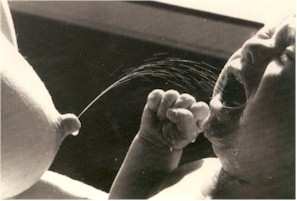 I always planned to nurse my babies, but I secretly worried that I wouldn’t have enough milk because of my breast size. They did get a bit bigger during my pregnancy (AA to B cup), but it seemed impossible that my small breasts would be able to produce enough milk to feed a baby.
I always planned to nurse my babies, but I secretly worried that I wouldn’t have enough milk because of my breast size. They did get a bit bigger during my pregnancy (AA to B cup), but it seemed impossible that my small breasts would be able to produce enough milk to feed a baby.
It was a big relief to me to discover that despite my breasts being small, they worked just fine when it came to breastfeeding, and I was able to successfully nurse all six of my babies.
Over the past thirty-five years of working with nursing mothers whose breasts came in an amazing variety of shapes and sizes, I have discovered that having small breasts is not a disadvantage for the nursing mother. In fact, having large breasts can actually make nursing more challenging, because women with large breasts have to worry more about engorgement, positioning, latch on (newborns with tiny little mouths may find it challenging to take large nipples and areolas into their mouths, and support (the increased amount of tissue is heavier when filled with milk, and requires heavy duty bras as well as more support to position the breast optimally during feedings).
I always had trouble finding nursing bras to fit because of my small breasts. It seemed as though all the nursing bra manufacturers automatically assumed that any mother who was lactating would automatically have huge breasts. After buying a drawer full of expensive nursing bras that just hung on me and never fit right, I finally gave up and decided to either go braless or wear stretchy little sports bras that could hold a nursing pad if needed, and could be pulled up or down when I needed to nurse.
Special nursing bras aren’t really necessary unless you need the extra support that they provide, and if your breasts are small, then that really isn’t an issue. I used to get frustrated every time I shopped for them. I usually ended up not wearing a bra at all. (Of course, there are many more choices in nursing bras today than there were thirty years ago.)
I remember one time my 9 year old daughter was in the dressing room with me, watching me try on bra after bra with no luck. She put her arms around me and said: “Mommy, it’s okay. Just think of it this way: when you get really old your boobies won’t sag and get all droopy like the rest of the Mommies!” That made me feel better, and you know what? She was right!
Fatty tissue is what gives the breast its rounded shape and protects the internal structures from injury. The amount of fatty tissue and the size of the breast are not related to the ability to produce milk, so small breasted women are just as capable of adequate milk production as the more amply endowed. Some of the most copious milk producers that I have encountered – including mothers of twins – have had very small breasts.
When you’re lactating, your breasts produce milk constantly, and it accumulates in the milk ducts between feedings. When your baby nurses, he will empty out most of the milk in the breast – usually about 75 – 80%. Breastfeeding moms can produce an equal amount of milk over a 24 hour period regardless of the size of their breasts, but women with large breasts may have more ‘storage capacity’ than those with smaller breasts.
That means that that a large breast may store more milk in reserve between feedings – sometimes several times as much as a small breast. For example: If a large breast contains 6 oz, and the baby takes 4 oz from each side at a feeding (8 oz total), that leaves about 2 oz in each breast (4 oz total) in reserve for the next feeding – in addition to the milk produced while the baby nurses.
Smaller breasts may contain 4 oz in on each side. If the baby takes 3 oz on each side (6 oz total) per feeding, that leaves about 1 oz in reserve in each breast (2 oz total) for the next feeding, in addition to milk produced while the baby nurses.
Because of this individual ‘storage capacity’, women with smaller breasts may need to nurse more often, because their babies may take in less per milk per feeding. Women with larger breasts may deliver more milk during each feeding, so the baby doesn’t need to nurse as often in a 24 hour period – or the baby may only take one breast per feeding.
All of these guidelines apply to the ‘average’ baby. Although larger breasts often have greater storage capacity than small ones, that doesn’t necessarily mean that your baby will nurse more or less often just because of the size of your breasts.
A mom with large breasts may have to nurse just as often, or even more often, than a mom with small breasts, because every mother baby couple is unique. These individual differences are another reason that babies need to be fed ‘on cue’ or ‘on demand’ and not according to a schedule. The baby removes the amount of milk he needs at each feeding, and this is what determines how often he needs to eat – not the clock.
There are some exceptions to the rule that breast size has nothing to do with the ability to produce an adequate supply of milk. A small number of women (estimated at one per thousand) have insufficient glandular tissue (IGT) in their breasts. This condition is also referred to as breast hypoplasia, hypoplastic breasts, or underdeveloped breast. Women with IGT don’t develop enough milk producing tissue during adolescence and pregnancy, so they aren’t able to produce enough breast milk.
In most cases, these women’s breasts look abnormal – asymmetrical ( one side significantly larger than the other), tubular, or extremely tiny and pendulous – but not always. You can’t determine how much milk a breast will produce just by how it looks, but unusual looking breasts may be a red flag for insufficient milk production.
No one is sure of the exact cause of IGT, but there seems to be a hormonal component. Women with PCOS (polycystic ovary syndrome); women whose mothers were exposed to the toxic chemical dioxin, an environmental pollutant, during their mother’s pregnancies (exposure to dioxin in utero can interfere with breast development during puberty and pregnancy); and those with fertility issues are more at risk.
The mother with IGT may produce some milk, and even a small amount provides nutritional benefits for her baby. Supplementing with formula, given either by bottle or a supplemental feeding system like Lactaid or SNS, are options for the mother who isn’t able to produce a full supply of milk.
It’s important to remember that breastfeeding is more than just a milk delivery system. Any amount of breast milk that your baby receives provides nutritional and immunological benefits, and the special closeness that you feel while nursing your baby is not dependent on how often he nurses, or how much milk you produce.
Anne Smith, IBCLC
Breastfeeding Basics
 Breastfeeding Basics
Breastfeeding Basics




